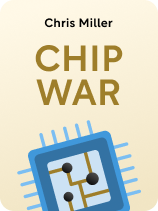What can we learn from Chris Miller’s Chip War? What is there to know about the economic history of the semiconductor?
In Chip War, Miller describes the growth of the semiconductor industry from invention to globalized mass production. He walks through each step of the semiconductor’s technological development, highlighting key international competitors in the industry.
Read on for insights and explanations drawn from Chris Miller’s Chip War.
About Chris Miller’s Chip War
In Chip War, economic historian Chris Miller explores the rise of the semiconductor industry. Through his analysis and recounting of this history in Chip War, Miller shows how semiconductor chips became the delivery mechanism for the binary code that powers our digital world—from personal computers to household appliances to advanced weapons systems. As Miller writes, chips have become a linchpin of geopolitical power and a resource that powerful actors, from entrepreneurs to national security strategists and politicians, have sought to control.
In this article, we’ll explore the founding of the chip industry in the US, the emergence of Japan and Taiwan as major centers of chip design and manufacturing, and the rise of China as a new geopolitical rival in the global semiconductor competition—sparking concerns among Western firms and governments as national security interests became intertwined in the chip industry.
| Critical Reaction to Chip War When it was published in 2022, Chip War was hailed as a timely narrative of the rise of the chip industry, its crucial role in today’s global economy, and its centrality to geopolitical strategy. In its review, The New York Times praised the book for its timeliness, relevance, and extensive research in tackling a complex and technical subject and making it accessible to a general audience. In particular, the Times noted the book’s valuable insights into the geopolitics of the semiconductor industry, particularly in the context of US-China relations—providing readers with an understanding of how technology competition shapes international relations. The review also celebrated the book’s exploration of the vulnerabilities and challenges in the global semiconductor supply chain, a topic that gained prominence when those supply chains were disrupted during the COVID-19 pandemic. Forbes likewise lauded the book’s success in conveying the geopolitical significance of the global semiconductor industry, especially commending Miller for his in-depth exploration of China’s ambitions to achieve self-sufficiency in semiconductor manufacturing. However, the review also noted that some readers might find that the book’s emphasis on the US-China rivalry overshadows other important aspects of the semiconductor industry, such as the role of other countries in the complexities of the global chip supply chain. |
The Cold War Context
The Cold War was the backdrop—and ultimately the impetus—for the emergence of the semiconductor industry. After the devastation of World War II, writes Miller, the United States and the Soviet Union emerged as the world’s two military and geopolitical superpowers. Over the next half-century, the two nations and their respective allies and satellite states would wage the Cold War—a titanic ideological, economic, and political conflict.
As Miller notes, the Cold War competition underscored the US military’s need for technology to guide its bombs, missiles, and eventually its satellites with precision. This is what ultimately drove the military’s insatiable appetite for computing power.
Discovering the Power of Semiconductors
It was in this broader historical context, writes Miller, that scientists discovered how semiconductors could be harnessed to spark a revolution in electronics.
From Vacuum Tubes to Transistors
Miller explains that the transistor was a game-changer for military—and, later, civilian—electronics. Up to this point, vacuum tubes were the primary electronic components in military hardware. Vacuum tubes are glass or metal envelopes that contain no air or other gasses inside. The vacuum inside the tube helps prevent the interference of gas particles with the flow of electrons.
But they were far from ideal. Vacuum tubes were bulky, prone to malfunction, and physically large, limiting their potential, particularly in military contexts. Transistors, on the other hand, were significantly smaller, lighter, and more efficient and durable.
The Rise of the Chip Industry
Following these discoveries, writes Miller, the 1950s saw a small group of engineers and entrepreneurs found the modern chip industry.
In 1958, Jack Kilby at Texas Instruments (TI) invented the integrated circuit, known today as the “chip.” These contained multiple transistors fabricated onto a single physical “chip” of semiconductor material (usually silicon). Chips took semiconductors to the next level, offering lower power consumption (and thus greater efficiency and durability) and enabling more compact designs.
Moore’s Law and the Expansion to the Civilian Market
Miller writes that new thinking about the growth potential of semiconductors fueled the optimism of these chip pioneers. In 1965, Gordon Moore (who, along with Noyce, cofounded the computer chip powerhouse Intel in 1968), predicted that the number of transistors that could fit on a microchip would double approximately every two years—while the cost per transistor would decrease.
This principle became known as Moore’s law, and its predictions have largely withstood the test of time for six decades. Miller writes that this had massive implications for the nascent chip industry, as it meant that computers and electronic devices would be able to perform increasingly complex tasks at faster speeds.
The Emergence of Japan
As the American chip industry began to take off in the 1950s and 1960s, writes Miller, Japanese entrepreneurs saw the potential of the technology to create new private fortunes—and transform their war-ravaged country into an economic powerhouse.
Visionary figures like Akio Morita, who founded Sony, recognized the potential of semiconductors for the consumer market—not just military applications. Sony started out as a small electronics shop in 1946, but its commitment to innovation and engineering excellence eventually led to the development of many groundbreaking products, including the first transistor radio in 1955 and the first all-transistor television in 1959. These products were more efficient, portable, and durable than their predecessors. The strategy of Japanese companies at this time, like Sony, was to license existing American technology. But they excelled at adapting American chips to use in consumer electronics such as radios, televisions, and handheld calculators.
The American Response
Advocating that chips were a strategic resource vital to American military and economic security, semiconductor industry heads founded Semiconductor Manufacturing Technology (SEMATECH) in 1987. SEMATECH was a consortium of semiconductor manufacturers, equipment suppliers, and the US government. Its primary mission was to advance semiconductor manufacturing technology and enhance the competitiveness of the US semiconductor industry by facilitating coordination between the Pentagon and the industry to enhance production and collaboration.
The Rise of TSMC and the Foundry Model
In this section, we’ll turn our attention to the rise of Taiwan Semiconductor Manufacturing Company (TSMC) and the Taiwanese chip industry beginning in the 1980s, the resulting shift to the foundry model for chip manufacturing, the corresponding shift to the “fabless” model for chip design, and the decentralization and globalization of the chip supply chain.
In 1987, Morris Chang founded TSMC, a public-private partnership that would become the dominant global player in chip manufacturing.
The Taiwanese government was eager to develop a domestic semiconductor industry to reduce its reliance on foreign technology and create a strategic economic advantage. Thus, they were enthusiastic about providing Chang’s initiative with significant support through financial incentives, access to resources, regulatory assistance, and tax incentives.
What truly set TSMC apart from other chip companies was its pioneering role in spearheading what’s known as the foundry model.
Instead of designing their own chips, TSMC only manufactured chips designed by other companies—they were a manufacturing workshop. This offered distinct business advantages for TSMC through economies of scale and the opportunity to hone its production capabilities.
The Advantage of Economies of Scale
Miller writes that by mass producing chips for multiple customers, TSMC could achieve cost efficiencies through economies of scale. A small chip manufacturer faces relatively high costs to manufacture each chip—they have to set up and run their manufacturing equipment, pay for labor, and cover other fixed costs, with those costs spread out over a small number of chips. Thus, if the small manufacturer spends $100,000 on those startup costs but produces only 1,000 chips, their cost-per-chip is $1,000. But a large-scale mass producer like TSMC might produce 10 million chips, dropping their fixed costs down to $0.01 per chip.
The Fabless Model
Miller writes that TSMC’s success also heralded a revolution in chip design, as the chip design industry shifted toward what’s become known as the “fabless” model—in which the company focuses only on chip design rather than design and manufacturing.
TSMC and other chip manufacturers enabled chip designers to outsource their manufacturing operations to companies engaged solely in manufacturing. By thus freeing themselves from the high startup costs of chip manufacturing, these designers can achieve the same optimization and efficiency in chip design that TSMC achieved in chip manufacturing.
The Decentralization and Globalization of the Chip Supply Chain
In the 2000s and 2010s, more designers began to shift to the “fabless” model, in which these companies no longer needed the fabrication equipment to manufacture their chips. Miller writes that this shift was a major factor in the globalization and decentralization of the chip supply chain—with the United States holding a smaller share of chip manufacturing as that side of the industry moved to Taiwan and other East Asian countries.
The Emergence of China
In this section, we’ll turn our attention to the increasingly prominent role of the People’s Republic of China in the global chip game. Specifically, we’ll look at China’s early attempts to establish an onshore chip industry; the recognition by Chinese leadership of the importance of semiconductors for the nation’s economic, military, and national security future; and the geopolitical concerns and challenges that China’s emergence as a major player in the chip industry has for the US and its allies.
According to Miller, in the late 20th and early 21st centuries China embarked on a significant journey to emerge as a global player in the semiconductor industry.
The Chinese government had a vision of making mainland China a global semiconductor powerhouse. They believed China’s low labor and manufacturing costs could lure semiconductor investment to the country, play a key role in the nation’s recovery from the radicalism and chaos of the Maoist era, and be the stepping stone for China to finally play a central role on the global stage.
The Push for Geopolitical Dominance
Miller notes that the Chinese leadership—notably General Secretary of the Chinese Communist Party Xi Jinping—recognized that China’s economic, military, and national security future depended on developing a homegrown, high-value semiconductor industry. They needed to move beyond assembling devices for global tech giants like Apple and Samsung and begin leading in chip design and manufacture.
In the 2010s, China began pouring tens of billions into its information technology sector, pushing both private investors and state-owned enterprises to invest and shift the center of technological innovation eastward.

———End of Preview———
Like what you just read? Read the rest of the world's best book summary and analysis of Chris Miller's "Chip War" at Shortform.
Here's what you'll find in our full Chip War summary:
- The history and rise of the semiconductor industry in the US and abroad
- How national security became intertwined in the chip industry
- How a spurned TI employee grew the chip industry in Taiwan






